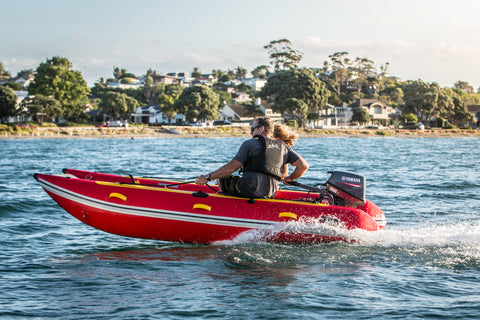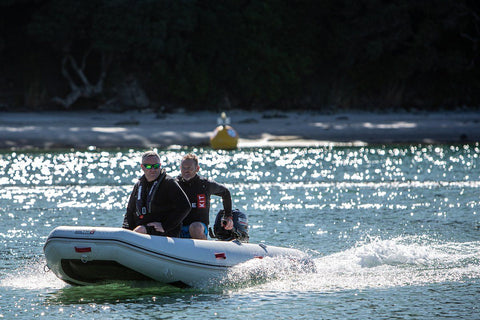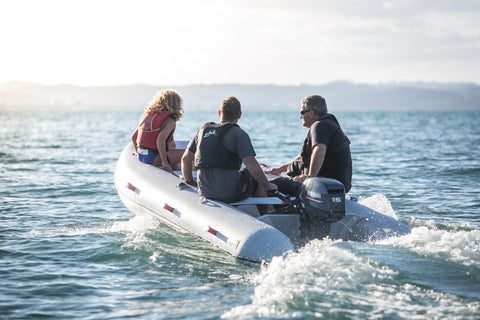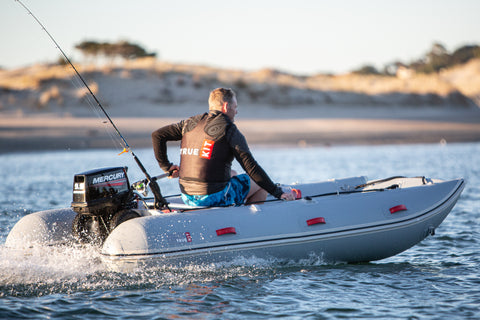At True Kit, we're not just about providing high-quality, portable inflatable catamarans; we're about enhancing your on-water experience. Whether you're a leisure sailor, a fishing enthusiast, or a family adventurer, optimizing your True Kit for peak performance can significantly enhance your outings. This guide delves into expert recommendations for engine choices, setup tweaks, and maintenance tips to ensure your True Kit inflatable boat performs at its best.

How to Optimize the Performance of Your Inflatable Catamaran
Weight Distribution: Balancing Act
Proper weight distribution is crucial for stability and performance. Distribute weight evenly, keeping heavier items centered and lower in the boat to improve handling and keep the boat level. A level boat on take-off from a standing start is particularly important. Boats will naturally go bow up and transom down when the power is applied. Getting the weight forward for take-off to counteract this can make a huge difference. Consider a tiller extension if you are alone in the boat to help get your weight forward. Misconceptions include the idea that it's only the total weight that matters. In reality, where weight is located can have a significant impact on performance.
Expert tip: A level boat is a well optimized boat - keep it level.
Engine Choice: The Heart of Performance
Picking the Right Engine
The choice of engine is pivotal in determining the performance of your True Kit catamaran. Consider power-to-weight ratios, fuel efficiency, and compatibility with your boat size. A common misconception is that more power always equals better performance. However, the optimal engine will balance speed with fuel efficiency and environmental impact, ensuring a smooth, powerful ride without overburdening the boat's design. Go for the engine that gives you the right balance between the speed you are looking for and weight you are comfortable lifting on and off the boat.
Expert tip: Look for the engine weight before purchasing, find the best power to weight ratio.
Shaft Length
Different designs of boats require different shaft lengths. The shaft length is typically measured from the point on the outboard that the outboard would sit on the transom down to the cavitation plate. Broadly speaking a short shaft outboard is around 15" and a long shaft is 20". This can vary slightly between brands and even models within a brand.
All True Kit inflatables perform best with short shaft outboards. We often get asked whether a long shaft can also be used. While a long shaft can be used it will add extra drag (meaning you go slower) and a bit more stress to the transom. Electric motors are measured slightly differently. These are measured down to the centre of the propeller. To take the popular ePropulsion Spirit model - we recommend Extra Short shaft for Navigator 250 and 300, Discovery 280 and Tactician 350. We recommend the Short Shaft model (longer than Extra Short!) for our Discovery 330 and 400 inflatables.
Engine Height and Trim
A key point to note is that all True Kit boats suit short shaft outboards. While longer shaft outboards can also be used if you already have one, the extra shaft length will cause unnecessary drag through the water. Important note: If you are choosing an electric motor like an ePropulsion please get in touch with True Kit for the specific recommendation.
Adjusting the engine height and trim can drastically affect your boat's efficiency and handling. Generally with one person aboard, you want your engine trimmed all the way down. The more weight you place towards the front of the boat, the more you will want to try testing one hole up on the tilt.
Another key point is: how deep your outboard sits in the water can be influenced by the weight onboard the boat, and the placement of that weight. If you feel your engine is sitting too low you can test raising it a little at a time. Using small 12mm thick plywood chocks is a good way to raise the engine a bit at a time. As a rule of thumb, the higher the engine the more efficiently it can run (but there is a limit!).
Expert tip: Test a small wood chock under your outboard to optimize engine height

Enhancing Performance with a Foil
Adding a hydrofoil to your outboard can offer significant benefits, including improved speed, fuel efficiency, and stability. By reducing bow lift, enhancing stern lift and directing the thrust horizontally, the foil can eliminate cavitation and provide more control. At True Kit we recommend the Permatrim Performance Foil as we have tested it extensively at it has come up trumps in side by side testing against other foils. Expert tip: Order and fit a Permatrim Performance Foil
What about Props?
The propeller is the real driving force behind any outboard. Many people only think about the engine and don't pay enough attention to the propeller. Propellers are very small relative to the size of the boat, yet they have to grip the water and propel the boat forwards without slipping. Think of a propeller as you might about the tires on your car on a wet road. The more tread that your tires have the better they will grip the road. With a propeller the pitch, rake and cup of the propeller are similar to the tread on your tires. Getting your propeller cupped can make a big difference to the performance of many propellers. Sometimes aftermarket propellers can also have a larger blade area and this helps performance of your True Kit. Expert tip: consider getting an aftermarket prop and getting it cupped

Inflation Pressures
As a general rule on a True Kit we recommend 3psi in the tubes and 10psi in the rigid airdeck. These are pressures that suit all-around performance. However, remember that the more air volume that you have in the boat, the higher the boat will sit in the water, and the more rigid the boat will be overall. So for optimum performance we would want a more pressurised boat when it has a higher payload in it, and reducing the pressures can help when you have a very lightly loaded boat.
Expert tip: If one up and lightly loaded, try reducing the pressures
Waterline Length
There are common misconceptions around how an inflatable boat will perform with a particular engine. Often people will think that the smaller the boat with the same engine, the faster it will go and the easier it will plane. The reality is almost the opposite. As a rough rule of thumb, in the True Kit range, the longer the boat the better the performance will be with the same outboard. Example: Put a 5hp outboard on a Navigator 250 and a Navigator 300, the 300 will performance faster with the same load.
Expert tip: Choose the longer boat if speed is your highest priority.

Regular Maintenance
Keeping up with regular maintenance will help you optimize your True Kit performance. This includes keeping the boat clean of dirt and oil, regular greasing of your outboard components, checking your propeller has not nicks or dings in it and ensuring that your inflatable boat is puncture-free. Expert tip: regularly check all aspects of your boat and motor for safety and optimal performance.
Personal Performance - Step up your game!
A common misconception is that the captain of a small inflatable does not influence the performance. However the truth is that the person in charge of the boat can dramatically affect the boats performance. Applying steady increases in power, adjusting the trim of the boat both fore and aft and side to side, control over the waves... there are so many aspects where you as the skipper affect performance. Get some time on the water, practice your take-offs and your turns, learn how to handle chop and waves. Become the master of your small craft. Expert tip: Get out on the water and learn your True Kit.

Optimizing your True Kit inflatable catamaran's performance is about understanding the nuances of your boat and how small adjustments can lead to significant improvements. By focussing on the key details discussed in this article you can ensure that your True Kit delivers the best possible experience on the water. Now it's time to enjoy your next boating adventure!
































